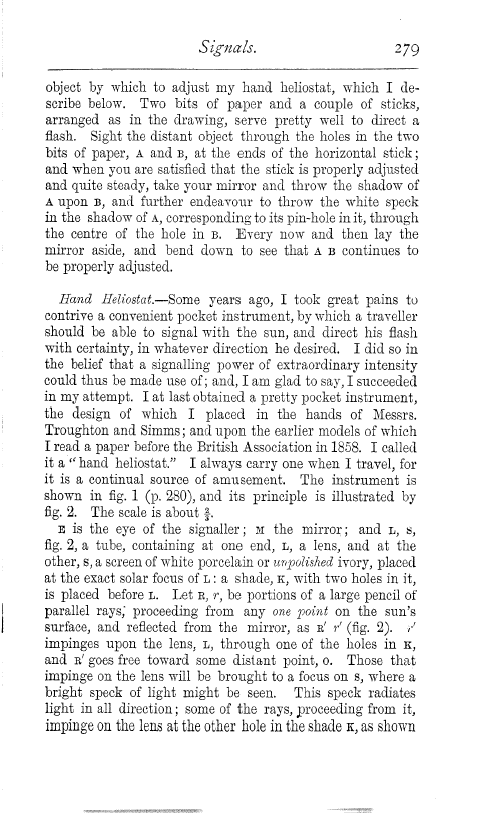Signals. 279
object by which to adjust my hand heliostat, which I describe below. Two bits of paper and a couple of sticks, arranged as in the drawing, serve pretty well to direct a flash. Sight the distant object through the holes in the two bits of paper, A and B, at the ends of the horizontal stick ; and when you are satisfied that the stick is properly adjusted and quite steady, take your mirror and throw the shadow of A upon B, and further endeavour to throw the white speck in the shadow of A, corresponding to its pin-hole in it, through the centre of the hole in B. Every now and then lay the mirror aside, and bend down to see that A B continues to be properly adjusted.
Hand heliostat.-Some years ago, I took great pains to contrive a convenient pocket instrument, by which a traveller should be able to signal with the sun, and direct his flash with certainty, in whatever direction he desired. I did so in the belief that a signalling power of extraordinary intensity could thus be made use of; and, I am glad to say, I succeeded in my attempt. I at last obtained a pretty pocket instrument, the design of which I placed in the hands of Messrs. Troughton and Simms ; and upon the earlier models of which I read a paper before the British Association in 1858. I called it a " hand heliostat." I always carry one when I travel, for it is a continual source of amusement. The instrument is shown in fig. 1 (p. 280), and its principle is illustrated by fig. 2. The scale is about 3.
E is the eye of the signaller ; 31 the mirror ; and L, s, fig. 2, a tube, containing at one end, L, a lens, and at the other, s, a screen of white porcelain or unpolished ivory, placed at the exact solar focus of L : a shade, x, with two holes in it, is placed before L. Let R, r, be portions of a large pencil of parallel rays, proceeding from any one point on the sun's surface, and reflected from the mirror, as R' r' (fig. 2). r' impinges upon the lens, L, through one of the holes in x, and R' goes free toward some distant point, o. Those that impinge on the lens will be brought to a focus on s, where a bright speck of light might be seen. This speck radiates light in all direction ; some of the rays, proceeding from it, impinge on the lens at the other hole in the shade K, as shown

